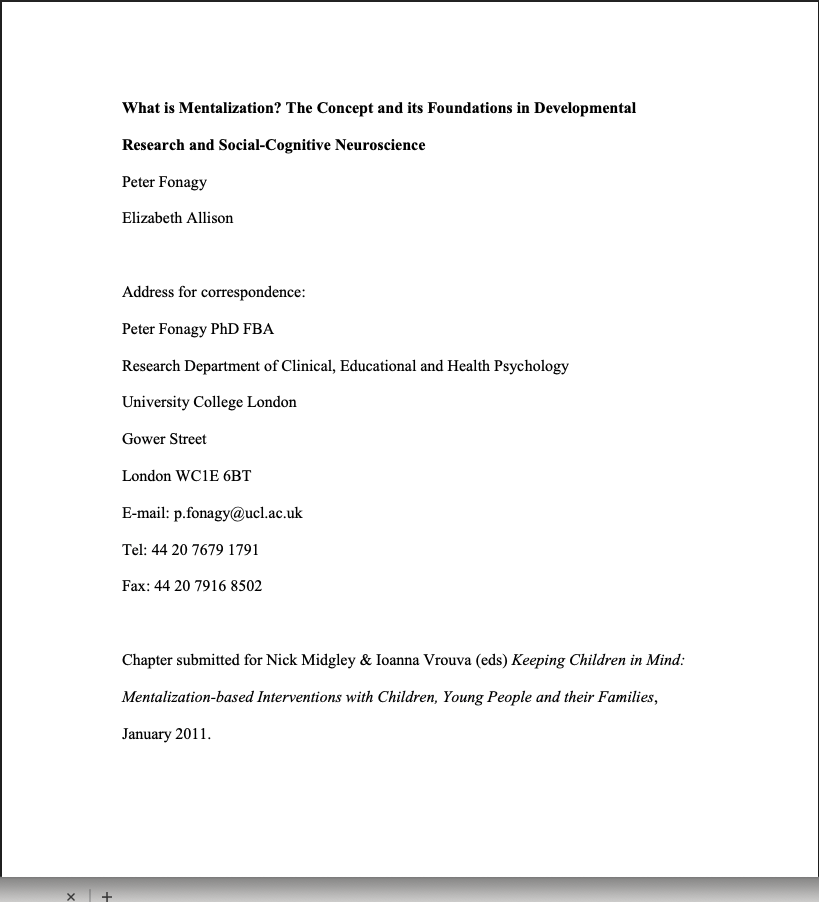Fonagy’s Mentalization
Like many people I have been using the 'empathy' to describe the process of thinking about other people's feelings and experiences. I heard Fonagy's name in a book about teen minds. After a just a brief dig into who he was, it was obvious that his flagship work was the theory of mentalization. This process of thinking about your own thoughts & emotions, combined with thinking about the thoughts & emotions of others is what Fonagy calls mentalization. The outcome of that thinking is empathy. As a strategist in the field of marketing I often 'put myself in the shoes' of various people. now I realise that I don't naturally empathise with the customer, I go through a process (mentalization) to imagine their thoughts and feelings which creates empathy.
0:00
/
0:00
Mentalization
Briefing Document: Peter Fonagy’s Mentalization Theory
This briefing document summarizes key themes and ideas from the provided sources on Peter Fonagy’s Mentalization Theory and Mentalization-Based Treatment (MBT).1. What is Mentalization?
Fonagy’s central concept, mentalization, is the fundamental human capacity to understand behavior (one’s own and others’) in terms of underlying mental states. These mental states encompass “thoughts, feelings, beliefs, desires, intentions, and goals.” It’s an active, largely preconscious, and imaginative process of “having one’s mind in mind” and “having others’ minds in mind.”- Beyond Empathy: Mentalization is distinct from, and more foundational than, empathy. As one source explains, “Empathy, according to Fonagy, is something you can feel for a person, based on your capacity to imagine what the other person is feeling. That capacity, however, that imagining of the other person’s experience that elicits your empathy—is mentalization.” An example given is understanding a partner’s pain and frustration after stubbing their toe, even when you are not experiencing the physical pain yourself.
- Imaginative and Inferential: We can never truly know what’s in someone else’s mind; therefore, mentalization involves inferring or imagining their internal world.
- Dual Aspects: It encompasses both self-reflection (understanding one’s own internal world) and interpersonal understanding (comprehending others’ internal worlds).
- Implicit and Explicit: Mentalization can be automatic and unconscious (implicit) or deliberate and conscious (explicit).
2. Development of Mentalization
The capacity to mentalize is not innate but is developed through early interpersonal experiences, particularly within secure attachment relationships with caregivers.- Caregiver Reflection is Crucial: When caregivers accurately reflect a child’s emotions and intentions, the child learns to recognize, name, and understand their own internal states. This process is “crucial for developing self-regulation, empathy, and resilience.” The sources emphasize that caregivers “name our feelings for us when we felt angry, disappointed, overjoyed, or scared,” demonstrating that “what is in our minds can be captured inside others’ minds.”
- Feedback Loop: This interaction creates a “feedback loop”: “we are understandable to others, which makes us understandable to ourselves, which makes us even more understandable to others.” This foundational understanding of self, derived from caregivers’ ability to mentalize the child’s experience, forms the basis for understanding others.
3. Importance of Mentalization
A strong mentalizing capacity is vital for healthy emotional regulation, stable relationships, and a coherent sense of self.- Breakdown Under Stress: When mentalizing breaks down, especially under stress or intense emotion, individuals “may struggle to understand themselves and others, leading to impulsive behavior, relationship difficulties, and emotional dysregulation.”
- Psychological Well-being and Social Navigation: Fonagy’s theory highlights that “our ability to navigate the social world and maintain psychological well-being hinges on our capacity to understand ourselves and others as beings with minds, driven by thoughts, feelings, and intentions.”
4. Mentalization-Based Treatment (MBT)
Developed by Fonagy and Anthony Bateman, MBT is a therapy specifically designed to enhance an individual’s mentalizing capacity.- Primary Goal: The core aim of MBT is “not to gain insight into past traumas but to recover and strengthen the patient’s ability to mentalize in the present moment, especially during emotionally charged situations.”
- Initial Application and Broader Use: MBT was “initially developed for Borderline Personality Disorder (BPD) but has been applied to other conditions like eating disorders, depression, and trauma.” It has been “shown to significantly help individuals with borderline personality disorder better understand and regulate their emotions.”
- Therapeutic Stance: The therapist in MBT adopts a “curious, non-knowing stance, encouraging the patient to explore different perspectives on their own and others’ experiences.”
- Therapeutic Relationship as Secure Base: The therapeutic relationship itself serves as a “secure base for the patient to practice mentalizing.”
- Techniques and Focus: MBT employs techniques like “clarification, exploration, and gentle challenging,” consistently aimed at “bringing attention back to mental states and their impact on behavior.” The primary focus remains on “how current difficulties and interpersonal interactions are affected by the patient’s mentalizing abilities,” rather than solely on past experiences.
- Psychotherapy as an Exercise in Mentalization: Psychotherapy, in general, is described as a “deep exercise in mentalization,” where the space to think and express helps patients become “accessible to yourself in a new and eye-opening way,” with the therapist providing the “very important experience of being understood.”

